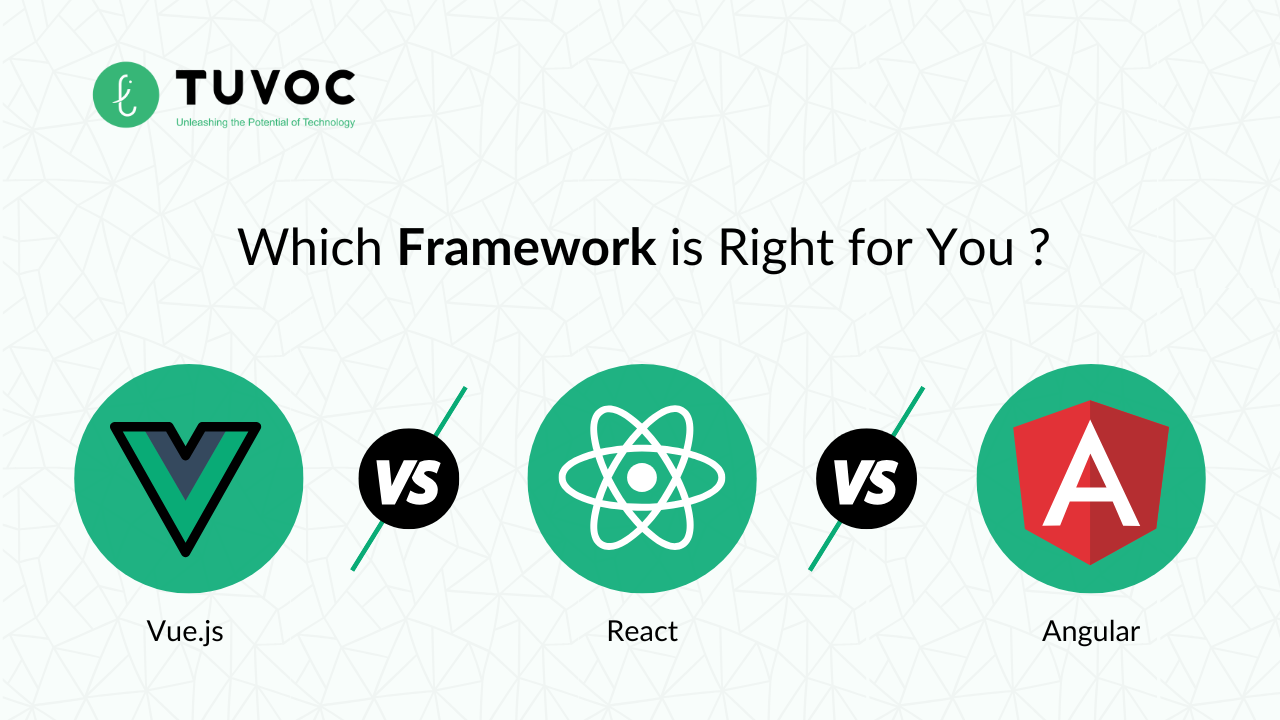We understand that selecting an appropriate framework is extremely crucial for project success. As a leading ReactJS development company, we understand the complexities involved in this decision-making process. We have compiled a detailed analysis of Vue.js, React, and Angular, while exploring how MLOps practices improve application development and deployment. The decision between these frameworks impacts everything from the speed of development and application performance to pair productivity and long-run maintenance.
Understanding the Framework Ecosystem
React
React is maintained by Meta and has established itself as the cornerstone in modern web development. Following ReactJS best practices has become important for delivering high-performance applications. The recent ReactJS 19: Updates and Features bring significant improvements to server-side components and concurrent rendering capabilities.
React’s component-based architecture promotes code reusability and maintainability. The virtual DOM implementation optimizes rendering performance by minimizing actual DOM manipulations. Key features include:
- JSX Syntax: Combines JavaScript with HTML-like syntax
- Unidirectional Data Flow: Predictable state management
- Component Lifecycle Methods: Fine-grained control over rendering
- React Hooks: Simplified state management in functional components
- Server Components: Enhanced server-side rendering capabilities
- Concurrent Features: Improved user interface responsiveness
For any ReactJS development company, staying current with these features is crucial for delivering optimal solutions.
Angular
The transition from Angular 15 to 16 marked an important moment in Angular’s evolution, introducing standalone components and simplified dependency injection. Angular 18: Latest Features continue this flow with the improved type safety and improved build performance. With organizations focusing on Angular performance optimization, these updates provide great benefits.
Angular’s comprehensive nature includes:
- TypeScript Integration: Enhanced type safety and developer tooling
- RxJS Integration: Powerful asynchronous programming capabilities
- Dependency Injection: Robust component architecture
- Angular CLI: Streamlined development workflow
- Angular Universal: Server-side rendering support
- Ivy Renderer: Improved compilation and rendering performance
AngularJS development has evolved significantly, with modern versions offering improved performance and developer experience. Recent Angular performance optimization techniques include:
- Differential loading for modern browsers
- Advanced tree-shaking capabilities
- Improved compilation strategies
- Enhanced lazy loading mechanisms
- Optimized change detection
- Advanced caching strategies
Vue.js
Vue JS development has gained a lot of traction due to its gradual learning curve and excellent documentation. Its component-based architecture aligns well with the modern development practices, making it particularly suitable for progressive web applications. The key advantages include:
- Template Syntax: Familiar HTML-based templates
- Reactivity System: Efficient state management
- Single-File Components: Improved organization
- Vue CLI: Modern tooling and development setup
- Composition API: Enhanced code reuse
- Custom Renderers: Flexible rendering targets
Framework Analysis
Community and Ecosystem Dynamics
React maintains the largest developer community, with approx 39.5% market share among the web frameworks. The robust ecosystem of a ReactJS development company majorly include extensive tooling and third-party integrations. This includes:
- State Management Solutions: Redux, MobX, Recoil
- UI Component Libraries: Material-UI, Ant Design, Chakra UI
- Testing Frameworks: Jest, React Testing Library
- Development Tools: React Developer Tools, Create React App
- Static Site Generators: Next.js, Gatsby
- Mobile Development: React Native
Development Experience and Learning Curve
AngularJS development teams frequently commend the framework for its extensive features and integrated solutions. Nevertheless, the learning curve tends to be more challenging than that of React or Vue.js. In contrast, ReactJS best practices focus on reusing components and managing state, which helps create maintainable codebases.
Framework-specific considerations include:
React
- Flexible and minimal API
- Strong focus on functional programming
- Extensive community resources
- Regular updates and improvements
- Clear upgrade paths
- Strong TypeScript support
Angular
- Structured development approach
- Comprehensive documentation
- Built-in testing utilities
- Strong enterprise support
- Regular release cycle
- Integrated development experience
Vue.js
- Gentle learning curve
- Clear documentation
- Flexible integration options
- Progressive enhancement support
- Active community
- Growing enterprise adoption
Performance Considerations and Optimization

The recent Angular performance optimization techniques and methodologies have significantly improved the initial load times. Vue.Js 3’s virtual DOM implementation has doubled booting up speed, even while ReactJS 19: Features and Updates focuses on reducing bundle sizes and improving runtime performance.
Key performance metrics include:
- Initial Load Time: Vue.js and React generally perform better
- Runtime Performance: All frameworks show similar characteristics
- Memory Usage: Angular has improved significantly
- Bundle Size: Vue.js typically has the smallest footprint
- Server-Side Rendering: All frameworks offer robust solutions
- Time to Interactive: React often leads in this metric
MLOps Integration
Modern web applications increasingly incorporate machine learning capabilities. The transition from Angular 15 to Angular 16 introduced better support for ML model integration, while Angular 18: Latest Features upscales type checking for ML-related operations.
Framework-Specific MLOps Considerations
React and MLOps Integration
- TensorFlow.js Integration: Native support and optimized performance
- Model Serving Optimization: Efficient data flow management
- State Management for ML Predictions: Specialized solutions
- Real-time Processing: Optimized rendering cycles
- Model Versioning: Integrated version control
- Performance Monitoring: Advanced debugging tools
Angular and MLOps Implementation
- TypeScript Support for ML Types: Enhanced type safety
- Angular Performance Optimization: Specialized for ML workloads
- Built-in HTTP Client: Robust API integration
- RxJS Integration: Streamlined data processing
- Dependency Injection: Simplified model management
- Testing Utilities: Comprehensive testing support
Vue.js and MLOps Architecture
- Lightweight Integration Options: Flexible implementation
- Reactive Updates for ML Predictions: Efficient state management
- Composition API Benefits: Enhanced code organization
- Custom Directives: Specialized ML interactions
- Plugin System: Extended functionality
- Performance Optimization: Efficient updates
Case Studies and Real-World Applications
Enterprise Implementation Success
A major financial institution’s Vue JS development team successfully implemented real-time fraud detection using MLOps practices, resulting in 40% faster model deployment cycles. Key achievements included:
- Reduced model deployment time
- Improved prediction accuracy
- Enhanced system reliability
- Streamlined development workflow
- Better resource utilization
- Increased customer satisfaction
Scale-up Success Stories
A ReactJS development company achieved significant improvements in user engagement by implementing progressive loading of ML features, demonstrating the benefits of ReactJS best practices. Results included:
- 30% improvement in user engagement
- 45% reduction in bounce rates
- 25% increase in conversion rates
- Improved application performance
- Enhanced user experience
- Better resource utilization
Making the Right Choice
Consider these factors when selecting a framework:
Team Expertise and Resources
- Angular: Suits teams with TypeScript experience and enterprise background
- React: Ideal for JavaScript-focused teams with varied skill levels
- Vue.js: Good for teams transitioning from jQuery or seeking gradual adoption
Project Scale and Complexity
- Angular: Enterprise-level applications with complex requirements
- React: Flexible for various scales, from small to large applications
- Vue.js: Excellent for incremental adoption and progressive enhancement
Performance Requirements and Optimization
- Angular Performance Optimization: Built-in tools and comprehensive solutions
- ReactJS 19: Features and Updates: Enhanced performance capabilities and optimizations
- Vue.js: Efficient by default with room for additional optimization
Future Outlook and Trends
The progression from Angular 15 to Angular 16 and beyond to Angular 18: Latest Features indicates a trend toward improved developer experience and performance. Similarly, ReactJS best practices continue to evolve, emphasizing efficient state management and component architecture.
Future developments likely include:
- Enhanced AI/ML integration capabilities
- Improved performance optimization tools
- Better developer experience
- Enhanced security features
- Improved testing capabilities
- Advanced debugging tools
Conclusion
Each framework offers distinct advantages:
React
- Flexibility and extensive ecosystem
- Strong community support
- Regular updates and improvements
- Excellent documentation
- Proven enterprise reliability
- Strong mobile development options
Angular
- Comprehensive solution for enterprise applications
- Strong typing and tooling
- Integrated development experience
- Regular release cycle
- Enterprise-grade security
- Robust testing capabilities
Vue.js
- Progressive framework with a gentle learning curve
- Excellent documentation
- Growing enterprise adoption
- Flexible integration options
- Strong performance characteristics
- Active community support
The decision ultimately hinges on particular project needs, the expertise of the team, and considerations for long-term maintenance. Whether collaborating with a ReactJS development company or focusing on Vue JS development, achieving success requires comprehending the strengths and weaknesses of these frameworks while applying effective MLOps practices.
Keep in mind that the most effective framework is the one that matches your team’s expertise, project needs, and organizational objectives. Continuously assessing updates to the framework and new best practices helps guarantee ongoing success in web development projects.
FAQs
React is a flexible library focused on building user interfaces, Angular is a comprehensive framework ideal for enterprise applications, and Vue.js is a progressive framework known for its gentle learning curve and simplicity.
Angular is typically preferred for large-scale applications due to its robust features, TypeScript support, and integrated development experience, making it suitable for complex projects.
React offers native support for TensorFlow.js and optimized performance for ML applications, Angular enhances type safety and API integration for ML workloads, while Vue.js provides flexible integration options with efficient state management for machine learning predictions.
When comparing performance, React often leads in time to interactive metrics, Angular has improved significantly in load times, and Vue.js generally offers the smallest bundle size, making it efficient by default.
Consider factors such as your team’s expertise (JavaScript vs. TypeScript), the scale of the project (small vs. enterprise-level), and specific performance requirements to determine which framework aligns best with your needs.
Have an Idea? Let’s Shape It!
Kickstart your tech journey with a personalized development guide tailored to your goals.
Discover Your Tech Path →Share with your community!
Latest Articles

How to Hire Bubble App Developers: Process, Tips & Strategies
Introduction Over three million developers have deployed 4.69 million applications worldwide, enabling businesses to enhance MVP development and launch it…

Understand Cost of Hiring Python Developers in 2025: Factors and Strategies
Note: The estimated cost of hiring Python developers can range between $ 15-17 hourly or more. The exact cost, team…

Top CTO Checklist for Hiring Python Developers
Introduction Python is among the popular programming languages due to its comprehensive libraries, frameworks, and versatility. Many popular companies like…





